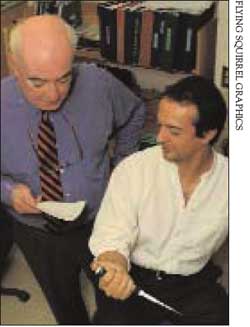Vital Signs:
DMS researchers
are fighting malaria
the molecular way
Every 30 seconds, malaria kills a child in Africa. Worldwide, 300 million people a year contract malaria and over a million die of it. Since 1995, doctors have used the drug atovaquone (ATV) to prevent or treat the deadly disease. But now some strains are proving resistant to ATV.
How does drug resistance arise? Using yeast, an international research team led by Dartmouth biochemist Bernard Trumpower has answered that question. The team's insights may lead to drugs that are harder for malaria to beat.
 Photo by Flying Squirrel Graphics |
| Biochemists Trumpower, left, and Kessl. |
ATV works by disabling an enzyme, called the cytochrome bc1 complex, that is essential for cell respiration during metabolism. Yet both human cells and the parasites that cause malaria have bc1. Why isn't ATV toxic to human cells? Because of one amino acid. The bc1 complex is a group of ten proteins clumped together; each protein is made of a string of amino acids folded into a complicated knot, with many holes and pockets. In the malaria parasite, ATV fits into a pocket in bc1 like a key into a keyhole. In human cells, the researchers found, the amino acid at the mouth of the keyhole is too large for the key to fit in. The drug can't bind to the enzyme and so can't disable it.
The bc1 in yeast matches that in the malaria parasite. And the human enzyme is just like the one in cows. Working with yeast and cow enzymes is safer and more practical than extracting enzymes from malaria (which would require a containment facility) or human blood. Yet getting bc1 from beef hearts has limitations; to make trial mutations in the enzyme, for instance, would require cloning a cow.
Yeast: Even so, comparing the amino acid sequences of the enzymes, the researchers saw that changing one amino acid would turn the yeast enzyme into the cow enzyme. Jacques Kessl, a research associate at DMS, worked with British researcher Brigitte Meunier to make the precise mutation needed.
"So we had models in the lab for both the infecting organisms and for the human beings they infect," explains Trumpower.
Collaborator Steven Meshnick at the University of North Carolina provided the amino acid sequence of the bc1 complex in ATV-resistant malaria. When the researchers genetically engineered their yeast models to carry those same changes, they found that the engineered yeast was, indeed, unaffected by ATV.
"The funny thing about one of the mutations," says Kessl, "is that it makes the yeast enzyme look like the cow enzyme." Adds Trumpower, "The pathogen has spontaneously acquired that exact same mutation. It escapes the drug by mimicking its host."
Cells: If ATV were changed to outwit this mutation, however, the drug would also kill human cells. "But by looking at that pocket where ATV bonds," explains Trumpower, "we thought it might be possible to design a new drug to take advantage of the differences."
The team is also targeting a second pocket in the same enzyme. This drug would be used in combination with ATV, making the treatment much harder for malaria to outwit. "If a mutation that allows ATV resistance happens one in a million times," notes Trumpower, "the parasite's chances of acquiring two mutations in the same enzyme that allow it to become resistant to two different drugs are one in 1,012 -it's almost impossible."
The new drugs will be tested on the dozen ATV-resistant yeast strains the lab has developed. Promising ones will be sent to Meshnick in North Carolina to test directly in malaria.
The team hopes to find one that's not only effective but also inexpensive to make. "Price is important because malaria is prevalent in poor countries," says Kessl. The best malaria drug, in other words, is one any mother with a sick child can afford.
If you would like to offer any feedback about this article, we would welcome getting your comments at DartMed@Dartmouth.edu.
